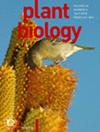Coupled hydraulic and whole-plant economic strategies in twenty warm-temperate woody species
IF 4.2
3区 生物学
Q1 PLANT SCIENCES
引用次数: 0
Abstract

20种暖温带木本植物的水力与全株耦合经济策略。
等向各向异性连续体描述了植物如何调节水势,并已被用于物种水力策略的分类。从慢到快连续体是一种资源获取和利用的全厂策略。水力与全厂经济策略之间的关系可以为评价工厂绩效提供综合的方法。我们量化了温带森林中20种木本植物的等水性。我们还测量了与水力和经济策略相关的其他功能性状(叶片气体交换、压力-体积性状、黎明前和正午水势、原生和最大茎部水力电导率、Huber值和木材密度),然后探讨了潜在的权衡。采用Pearson相关性和PCA来评估等水性与其他功能性状之间的关系。我们发现了一系列协调的等各向异性和慢速光谱,其中物种的水力导电性损失百分比(PLC)和木材密度(WD)是两个最有力的指标。在协调连续体上,各向异性物种的叶片气体交换、PLC和膨胀损失点水势均高于等水型物种,而WD则低于等水型物种。我们发现,在全球气候变化的背景下,干旱事件将更加频繁和严重,因此等水合种具有更高的耐旱性,使其比各水合种有更大的生存机会。识别植物生态策略之间的相关光谱可以增加对温带森林木本植物如何响应气候变化的理解。
本文章由计算机程序翻译,如有差异,请以英文原文为准。
求助全文
约1分钟内获得全文
求助全文
来源期刊

Plant Biology
生物-植物科学
CiteScore
8.20
自引率
2.60%
发文量
109
审稿时长
3 months
期刊介绍:
Plant Biology is an international journal of broad scope bringing together the different subdisciplines, such as physiology, molecular biology, cell biology, development, genetics, systematics, ecology, evolution, ecophysiology, plant-microbe interactions, and mycology.
Plant Biology publishes original problem-oriented full-length research papers, short research papers, and review articles. Discussion of hot topics and provocative opinion articles are published under the heading Acute Views. From a multidisciplinary perspective, Plant Biology will provide a platform for publication, information and debate, encompassing all areas which fall within the scope of plant science.
 求助内容:
求助内容: 应助结果提醒方式:
应助结果提醒方式:


